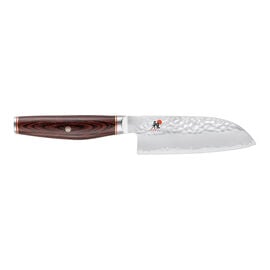Santoku Knives
A Santoku knife is a versatile Japanese kitchen knife known for its unique design and multi-purpose functionality. Santoku knives have a short, wide blade with a flat edge profile.
Santoku knives are highly versatile and are often compared to Western Chef knives because of their ability to do it all. With their precision in making clean cuts and a comfortable grip due to their wide blades, they are the perfect choice for a wide range of culinary tasks, including chopping vegetables, slicing meat, and preparing fish. Some Santoku knives are crafted from Damascus steel, which enhances the knife's strength and creates distinctive blade patterns. Known as the 'universal knife' in Japanese cuisine, they are celebrated for their precision and versatility.
A Santoku knife is an excellent 'beginner's knife' for chefs who want to learn more about Japanese cooking knives. Due to its lightweight and balanced design, it is easy to handle and suitable for a variety of kitchen tasks, especially pressure cutting applications.
The typical blade length of a Santoku knife ranges from 5 to 7 inches, making it a versatile size for various kitchen tasks.
The key differences between forged and stamped Santoku knives lie in their manufacturing processes, weight, balance, blade quality, and price.
Forged Santoku Knives are created through a traditional process where a single piece of steel is heated and hammered into shape. This method often involves manual craftsmanship. Forged knives are generally heavier and better balanced, offering a sturdy feel and greater control during cutting. The blades of forged knives are known for their strength, durability, and longer-lasting sharpness. However, these qualities come with a higher price tag due to the intensive labor and quality of materials used.
Stamped Santoku Knives are produced by cutting out the knife shape from a large sheet of steel, using a more automated and efficient process. These knives are lighter and may not have the same balance as their forged counterparts, but they can be easier to handle, especially for extended cooking tasks. While modern stamped knives can be high-quality, they may not retain their edge as long as forged knives and might not be as durable. The advantage of stamped knives is their affordability, making them a popular choice for budget-conscious consumers.
Santoku knives are specifically designed to enhance the food preparation process. The design of the Santoku knife, with its straighter edge and uniform blade width, helps in achieving consistent thickness in slices. This uniformity is not only aesthetically pleasing but also ensures even cooking. Many Santoku knives feature a Granton edge (hollowed-out grooves on the sides of the blade), which helps to prevent food from sticking to the blade. This feature is particularly useful when slicing sticky or wet foods, making the preparation process smoother and faster.
Santoku knives typically have a shorter, lighter, and thinner blade with a flatter edge compared to Western chef's knives, making them excellent for precise cutting tasks.
A Hollow Edge Santoku Knife features oval-shaped indentations along the blade's edge, creating air pockets that prevent food from sticking to the blade. It's ideal for slicing foods like potatoes, apples, or cheese, which tend to stick to the blade during cutting.
A Rocking Santoku Knife has a slight curve along the edge of the blade, allowing for a rocking motion during chopping. This design makes it versatile for various cutting techniques, such as chopping, dicing, and mincing, especially useful for herbs and vegetables.
The Hollow Edge Rocking Santoku Knife combines the features of both hollow edge and rocking Santoku knives. It has a curved blade for rocking cuts and hollow edge to reduce food sticking. This hybrid design is versatile, suitable for a variety of cutting tasks and is especially effective for both non-stick cutting and versatile chopping/mixing.










































